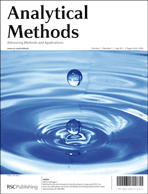A novel, simple and reliable method for the determination of trace copper on glassy carbon electrodes (GCEs) modified with co-poly(cupferron and β-naphthol)/gold nanoparticles (GNPs) is reported. The present work realized the application of principle of organic co-precipitation in solution into electrochemical analysis. First, the co-poly(cupferron and β-naphthol) was electrochemically deposited on the prepared GNPs/GCE by CV scanning in order to obtain co-poly(cupferron and β-naphthol)/GNPs/GCE. Then, the chelating ligand cupferron on the surface of the modified electrode and copper ion in the solution form the chelate complex (Cu(II)-Cpf), at the same time, the Cu(II)-Cpf was induced to be adsorbed by the carrier β-naphthol on the surface of the modified electrode by the principle of organic co-precipitation. Thus, the Cu2+ of the coprecipitated complexation can be detected at the co-poly(cupferron and β-naphthol)/GNPs/GCE. Therefore, preconcentration-separation and electrochemical detection of trace copper were simultaneously and synchronously carried through. After optimization, two linear responses were obtained in the concentration range from 9.0 × 10−10 to 4.5 × 10−8 M and 5.0 × 10−8 to 1.5 × 10−6 M, with a low detection limit of 5.0 × 10−11 M. This modified GCE does not present any significant interference from Cd2+, Ag+, Fe3+, Pb2+, Cr3+, Zn2+, NO3−, Cl−, SO42− and EDTA. No deterioration was observed in the electrode response during at least 3 weeks of successive measurements. And the modified electrode shows high selectivity, sensitivity and stability. The proposed method provides a new way for the separation, enrichment and electrochemical detection of trace copper ion.


 Please wait while we load your content...
Please wait while we load your content...